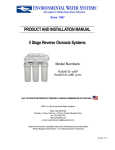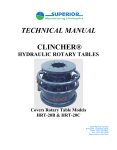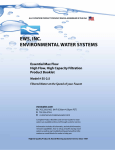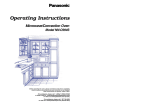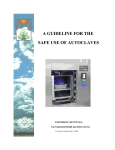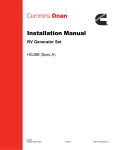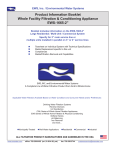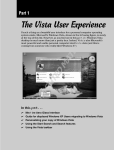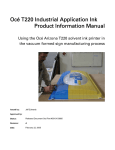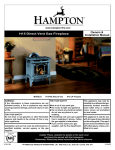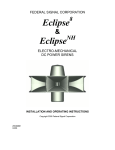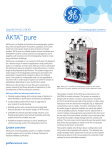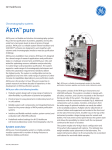Download Softener Series - Environmental Water Systems
Transcript
EWS, Inc. / Environmental Water Systems 4.3-1 Care and Use Manual Metered Softener Series Information Provided for the Proper Set-Up, Installation and Start-Up of the following Softeners: Cabinet “all-in-one” Style: RT 935 RT 1035 Twin Tank (resin tank with separate brine tank) Style: TT 1054 TT 1354-11/2 ALL PRODUCT PROUDLY MANUFACTURED AND ASSEMBLED IN THE USA To the Installer: Please Read and Leave this Owner’s Manual with the Unit or the Consumer To the Consumer: Retain this Care & Use Manual for Product Registration and Future Reference www.EWSWATER.com EWS, Inc. / Environmental Water Systems 4.3-2 IMPORTANT GENERAL INFORMATION AND PRE-INSTALLATION CHECKLIST FOR ALL EWS, INC./ENVIRONMENTAL WATER SYSTEMS POINT OF ENTRY PRODUCT Inspect and Verify: That all components are included with the unit and were not damaged in shipping. If there is obvious damage to any equipment, it must be noted on the carrier’s Bill of Lading. Open and inspect the contents of all closed crates, boxes or cartons, and inspect for concealed damage. The manufacturer is not liable for any damage during transit, as stated and published in the conditions of sale, the receiving packing slip and accepted invoice. The manufacturer has made every effort to ensure goods should be received in good condition and will support all legitimate claims against any carrier on behalf of the receiving party. Please see reverse side of all receiving packing slips and yellow labels affixed to boxes for your rights. Caution: Do not attempt to install any system using defective or damaged components. Do not install any system that has been misapplied based assumed water conditions. Do not install any system that has been misapplied based on usage, line service and/or the conditions and standards of operation stated below. Warning: When drilling or cutting, use protective eyewear to prevent possible eye injury due to flying objects. When using an open flame and/or hot materials, take the necessary precautions for you and the environment to prevent burns, burning and/or fires. CONDITIONS AND STANDARDS OF OPERATION Water Conditions and Issues: Water must be potable and must be micro-biologically correct. Water must be of a known quality or tested completely and independently to determine its quality, either municipally-treated or non-regulated, individual or community, well water. Please see in this manual: Qualifications and Applications, Standard Industry Terms and the Limited Warranty. Information provided for proper specifications are included in our published product manuals, and available through customer service and on our website. A simple emphasis on, and test for, water hardness is inadequate. Water issues with iron and/or manganese require their removal by a separate filter unit installed ahead of any other unit. Water Pressure and Flow Rate: A minimum of 30 PSI (40 PSI for Iron units) and 8 GPM (12 GPM for 1354 Iron units) is required for a backwash or regeneration valve to operate effectively. Water pressure not to exceed or to surge in excess of a maximum of 75 PSI for the system. Unsure of pressure or it’s ability to surge? A pressure reducing valve (PRV) becomes an insurance policy and is highly recommended for this and many other products that limit high pressure in your home. Excessive pressure will void product warranty. Water Temperature Range: Feed water temperature not to exceed 110°F or be allowed to go below 40°F. Protect unit from exceeding high temperatures and never allow unit, its’ drain line and any water to freeze. Electrical: An uninterrupted alternating current (A/C) supply is required for the operation of the control timer. Please make sure your voltage supply is compatible with your unit before installation. Low 24 voltage step down transformer 120v, 50/60Hz Existing Plumbing: Condition of existing plumbing and water heaters should be free from lime and iron buildup. Piping that is built up heavily and clogged with lime and/or iron should be replaced. Old galvinized or combinations of plumbing materials and their installation can cause separate water issues and conditions not related to water systems. Location of Equipment: Units can be installed, almost anywhere. Inside or outside. Valves may be water resistant, not water proof. Protect any system from the elements. Position equipment upright in its’ designated location, setting on a flat surface. Level equipment as required. Equipment out of plumb can exhibit poor flow characteristics which will affect the performance of the system. Plumbing and Installation: Connect raw water supply to bypass inlet connection. Connect treated water bypass outlet to home service line. Pipe sizes should be equal to or one size larger than the valve connection (3/4” line with 8 gpm to standard 1” valving is acceptable). NO Torch, NO Heat - solder all piping as sub-assemblies before installing. Internal valve damage can result from solder and/or torched heat By-Pass Valves: All 1” noryl plastic valving are supplied with a 1” high flow dual-port bypass valve and male-threaded yoke which are required for usage on these systems. On larger brass valves (1”HF, 11/2”, 2” and larger) the installation of a plumbed bypass with 3 shut-off valves and unions is required, as specified per unit, in this service manual. The need for a proper bypass is required by warranty and is necessary to isolate the system for maintenance and service. Drain Connection: Drain line should be sized to handle maximum drain line flow rates for the system as designated on the control valve. Minimum required drain line size at the valve (1/2” for all 1” valves, 3/4” for all 11/2” valves and larger). Recommended one pipe size larger for runs of 10 feet or more. Avoid overhead pipe runs, as undue backpressure can affect operation of backwash/regeneration. See backwash (tank filtration systems) and regeneration (softeners) differences, capabilities and restrictions - in drain connection procedures in those service manuals for those specific units. ALL SPECIFICS TO EACH SYSTEMS’ SET-UP, INSTALL AND START-UP IS AVAILABLE IN THE SERVICE MANUAL. WARNING: IMPROPER INSTALLATION AND/OR APPLICATION WILL RESULT IN THE VOIDING OF ANY PRODUCT WARRANTY. All plumbing should be done in accordance with all local plumbing codes. www.EWSWATER.com EWS, Inc. / Environmental Water Systems 4.3-3 INSTALLATION SUMMARY - SOFTENERS Step 1: Locate the following: Main Water Supply Line, Soft Water Loop or Inlet to Water Heater(s) (depending on application or restrictions) Drain Access, Electrical Outlet and Clearances. Step 2: Check the incoming Water Pressure. Install a pressure regulator (PRV) if the water pressure exceeds or can surge above 75 PSI. Step 3: Place the tank where you want to install the unit, making sure the tank is level and on a firm base, noting the clearances necessary to complete the installation. Step 3A: TT Units or “Twin Tank” style, place separate brine tank 6” from softener resin tank. Connect the safety brine assembly found in the brine tank to the 3/8” plastic compression fitting, then pass the tubing through the hole provided in the brine tank and connect to brass compression fitting on side of valve. Warning: Do not exceed connecting distance determined by the length of 3/8” OD poly tube provided. Step 3B: Cabinet Units “all-in-one” style softeners have the brine tank incorporated within the cabinet along with the resin tank. The connection between the valve and the safety brine assembly has been factory assembled. Step 4: Install at barbed connection on brine tank side, min. 5/8” OD tubing (not supplied) to a suitable drain. Warning: This is a gravity fed tank drain, in any event that could cause an overflow of the brine tank. Step 5: Tighten the Valve on the Tank. Caution: Since handling and moving the unit may loosen the valve head - Hand Tighten the Valve Head in a Clockwise Direction. Make sure tank cover, if applicable does not interfere or cut into the connection. Step 6: Identify Water Supply. Connect raw water supply to bypass inlet connection. Connect treated water bypass outlet to home service line. Units: RT935, RT1035 and TT1054 come with dual port bypass valve and male yoke TT1354-11/2” needs the bypass plumbed by the installer (see additional details) Warning: Plumb the unit with the bypass and the male yoke included, or for larger brass valves, a bypass must be plumbed with 3 shut-off valves and unions. Do not cross-connect or plumb backwards. UNTIL START-UP PROCEDURES - KEEP ALL VALVES TO/FROM SYSTEM CLOSED Step 7: Connect a backwash drain line (1/2” or 3/4”) based on application and an air gap. Warning: The performance of softeners are dependent on the proper flow rates for regeneration discharge FOLLOW START UP PROCEDURES BEFORE LEAVING THE JOB www.EWSWATER.com 4.3-4 EWS, Inc. / Environmental Water Systems Set-Up and Installation for All 1” Valves: RT 935, RT 1035, TT 1054 top view: back: outlet side: inlet side: to the home filtered supply from main left right Yoke 1” MNPT Dual Port Bypass O-Ring Connect Valve Head Outlet (filtered) Side: left side view of valve and drain port with included drain adaptor, bypass and male yoke Must use dual-port, full flow, noryl bypass with 1” MNPT yoke. •Shuts off water to/from the unit •No additional plumbing for media replacement or maintenance •Less costly plumbing installation, easier startups, non-corrosive front: Inlet (supply) Side: right side view of valve and brine line with included bypass and male yoke USING THE CONNECTED BYPASS VALVE AND 1” MALE NPT YOKE. PLUMB INLET (supply) AND OUTLET (filtered) INTO THE UNIT. •Follow the directional arrows molded onto the valve body and bypass. See pictures below for; top/front/back and left/right views to prevent plumbing the unit backwards. Teflon tape is the only sealant to used on any of our fittings. WARNING: No pipe dope. •NO Heat, No Torch; Leave at least 12” between the male yoke and any solder joints. Failure to do this could cause interior damage. Consider flexible stainless (1”FNPT x 1”FNPT (3/4” if your application) and at least 18” in length) connected to copper male adapters, or some other applicable connection - no heat, saves time, neat install, if applicable/code to your application. WARNING: ONCE PLUMBED, DO NOT TURN ON WATER, UNTIL YOU BEGIN START-UP PROCEDURES. Set-Up and Installation for 11/2” Valves: TT 1354-11/2 Materials Needed for Installation: Back Side: Union 11/2” pipe length to be determined Electric 3 - 11/2” Ball Valves Outlet (filtered) 2 - 11/2” Unions Side See Drain Requirements Front Side: 11/2” 2850 Valve Valve Cover: Black NEMA 1 Rated for resistence to dust and moisture. Union DO NOT TURN ON WATER, OPEN ANY VALVES OR PLUG IN THE ELECTRICAL UNTIL YOU GO TO THE START-UP PROCEDURES Drain: 1” MNPT Connected (included) to: Brass Flow Control Housing with 10 GPM Flow Restrictor 1” FNPT x 3/4” FNPT Drain Bypass Valve Hinged: left Opens: from right Controls: inside Inlet (supply) Side Materials Needed for Drain: 3/4” copper x male adapter 3/4” union 3/4” (min) drain line length to be determined PLUMB INLET (supply) AND OUTLET (filtered) INTO UNIT AND PLUMB BYPASS VALVE BETWEEN. •Follow the directional arrows molded onto the valve body. See picture below for correct set-up. •Use unions (a quick disconnect feature) at the inlet and outlet pipe, as pictured, to allow future servicing of system without cutting and replumbing •Use Ball Valves (preferred - easy to turn on/off) at inlet/outlet pipes and bypass, as pictured for proper installation. •NO Heat, No Torch; Leave at least 12” between the valve body and any solder joints. Solder joints prior to connecting to valve body. Failure to do this could cause interior damage. Teflon tape is the only sealant to used on any of our fittings. WARNING: ONCE PLUMBED, DO NOT TURN ON WATER, UNTIL YOU BEGIN START-UP PROCEDURES. www.EWSWATER.com EWS, Inc. / Environmental Water Systems 4.3-5 Start-Up Procedure for All Units The tank unit(s) have now been plumbed in with the inlet, outlet and drain connections made in accordance with the manufacturer’s recommendations and meets applicable plumbing codes. Now, it is time to fill it with water, plug the unit in, and properly start it up by following the start-up procedures below. These units are similar to water heaters and other point of entry product. They must be plumbed correctly and filled slowly while relieving pressure. These units are also similar to other sink filtration product. They must be flushed before beginning usage. Making the connections, turning on the water and walking away is an improper installation. Period. Failure to start up unit properly may cause service issues, unhappy consumers, and will void the warranty. STEP 1: FILL THE TANK WITH WATER - SLOWLY! Units: RT935, RT1035, TT1054 Units: TT1354-11/2 See Left Column See Right Column You Must Use: Bypass and Male-Threaded Yoke Included You Must Plumb: Inlet/Outlet and Bypass per Schematic STEP 1-A: PARTIALLY OPEN INLET SIDE ONLY Following a slow fill procedure will make the backwash and flushing steps easier and more effective. PARTIALLY OPEN - 1/4 TURN (as illustrated) on inlet supply side only to fill tank slowly. Keep outlet side closed PARTIALLY OPEN -1/4 TURN with (preferred) Ball Valve or Slowly and Partially Open Gate Valve on inlet supply side only to fill tank slowly. Keep outlet side and bypass valves closed. Inlet Side: Open 1/4 turn only to slowly fill Inlet Side Partially Open Once the tank has been slowly filled, go to the next page. Follow the remaining simple procedures. www.EWSWATER.com 4.3-6 EWS, Inc. / Environmental Water Systems STEP 1-B: TANK IS FILLED, OPEN INLET COMPLETELY SLOWLY OPEN - (as illustrated) on inlet supply side only. Keep outlet side closed. SLOWLY OPEN -Completely open (preferred) Ball Valve or Gate Valve on inlet supply side only. Keep outlet side and bypass valves closed. Inlet Side: Open Position once filled Inlet Side Open Tank is completely filled when sound of water stops or at a slow pace of 1-2 GPM it will take 5-10 minutes. Keep outlet side closed until later. STEP 2: PLUG IN THE ELECTRICAL Plug the 24 volt transformer into any unswitched electrical outlet or an acceptable extension to that outlet. Be sure that if plugged into a GFI outlet that the outlet has been reset. Please inform the consumer of the need for an unswitched outlet which can not be turned off and that GFI outlets need to be occassionally checked for operation. Please follow all applicable local codes. If using an extension, make sure of a complete and secure connection. No spliced connections. Do not break into wires with fasteners or staples. Make sure transformer has a snug and secure connection to outlet (larger units must use set screws to secure transformer to outlet). Electrical is used to bring power to the digital valve, in order to keep the time and operate the automatic backwash program. Cost of this operation is similar to the cost of a radio alarm clock. STEP 3: BEGIN THE REGENERATION CYCLE STEPS AS FOLLOWS FOR START-UP THESE STEPS ARE CRITICAL FOR THESE HIGHLY EFFICIENT METERED VALVES PLEASE FOLLOW THE STEP BY STEP INSTRUCTIONS Address Advancement Note: Push and Hold Extra Cycle Button for approximately 5 seconds to advance the valve into Regeneration Cycles. As each Regeneration Cycle is Entered a Red Dot will Illuminate on the left of the Regeneration Cycle Title printed on the face panel. To advance to the next Regeneration Cycle before it times out, Push the Extra Cycle Button once (Do Not Hold) once the Number on the left of the Address Display stops flashing. www.EWSWATER.com EWS, Inc. / Environmental Water Systems Begin the Regeneration Cycle Steps as follows for Start-Up · Push and Hold Extra Cycle Button for approximately 5 seconds to advance the valve into regeneration and to the Tank Fill Address. • Tank Fill Display [ 1 - - - - 5.0 ] Allow the Tank Fill to complete the Cycle and Confirm the water is being delivered into the Empty Brine Tank. Allow the valve to advance to the next cycle without assistance. 1 - - - - 5.0 NOTE: While waiting for the Cycle to complete check for leaks at Plumbing connections and Factory connections which have been loosened during Shipping and Handling. · Brine Making Display [ 2 - - - 15.0 ] Once the valve has Advanced into the Brine Making Cycle wait until the number (2) stops flashing. Push the Extra Cycle Button Once to advance Valve to the next cycle. 2 - - - 15.0 www.EWSWATER.com 4.3-7 4.3-8 · EWS, Inc. / Environmental Water Systems Brine/Rinse Display [ 3 - - - 60.0 ] Once the valve has Advance into the Brine/Rinse Cycle wait until the number (3) stops flashing. Push the Extra Cycle Button Once to advance Valve to the next cycle. NOTE: A slight sound change of the water flow will occur as the flow slows down through the valve. 3 - - - 60.0 NOTE: While waiting for the Cycle to complete check for leaks at Plumbing connections and Factory connections which have been loosened during Shipping and Handling. Clean up the Work Area. · Backwash Display [ 4 - - - 10.0 ] Open the 1” High Flow Bypass Valve inlet into the fully open position. The Backwash Cycle will Flow water Upward through the Mineral Bed to purge air bubbles and any color to the Drain. Allow the Backwash to run until the Drain runs clean and clear, approximately 0-5 minutes. Once the Drain is clean and clear Advance Push the Extra Cycle Button Once to advance Valve to the next cycle. www.EWSWATER.com 4 - - - 10.0 EWS, Inc. / Environmental Water Systems · 4.3-9 Fast Rinse Display [5- - - 10.0 ] This is a hidden cycle - NO red dot will appear Once the valve has Advanced into the Fast/Rinse Cycle wait until the number (5) stops flashing. Push the Extra Cycle Button Once to advance Valve to the Service mode. 5 - - - 10.0 Service Mode designated by Alternating flashing Time of Day and Gallons Remaining Repeat the Regeneration Cycle steps once Again as follows • Tank Fill Display [ 1 - - - - 5.0 ] Once the valve has Advanced into the Tank Tank Fill Cycle wait until the number (1) stops flashing. Push the Extra Cycle Button Once to advance Valve to the next cycle. • Brine Making Display [ 2 - - - 15.0 ] Once the valve has Advance into the Brine Making Cycle wait until the number (2) stops flashing. Push the Extra Cycle Button Once to advance Valve to the next cycle. • Brine Rinse Display [ 3 - - - 60.0 ] Once the valve has Advanced into the Brine Rinse Cycle Confirm the water is being Drawn out of the Brine Tank. Allow the water to be drawn out of the tank until the air check activates, approximately 2-10 minutes. The Brine Tank will Not completely empty the water below the Air Check Level. Push the Extra Cycle Button Once to advance the Valve to the next cycle. • Backwash Display [ 4 - - - 10.0 ] The Backwash Cycle will Flow water Upward through the Mineral Bed to purge air bubbles and any color to the Drain. Allow the Backwash to run until the Drain runs clean and clear, approximately 0-5 minutes. Once the Drain is clean and clear Advance Push the Extra Cycle Button Once to advance Valve to the next cycle. • Fast rinse (hidden cycle) Display [5- - - 10.0 ] Once the valve has Advance into the Fast Rinse Cycle wait until the number (5) stops flashing. Push the Extra Cycle Button Once to advance Valve to the Service mode. www.EWSWATER.com 4.3-10 EWS, Inc. / Environmental Water Systems STEP 4: THE “HOME STRETCH” 1: Once the regeneration cycles steps have been completed the; Service Mode will be entered. You will see alternating flashing Time of Day and Gallons Remaining 2: Now and only now is it time to add clean Softener Salt into the Brine Tank, Maximum: RT Units - 200 lbs; TT Units - 300 lbs. Recommended: Rock Salt 3: Slowly Open the 1” High Flow Bypass Valve outlet to the Service line or the 11/2” Outgoing Valve outlet to the Service line (if applicable, keep plumbed bypass valve closed). See Diagram Below. 4: Set the current Time of day using the Up and Down Arrows to adjust as needed. Please note for afternoon time settings the PM designation in small letters in the Middle of the Display window’s top edge should be illuminated. 5: Confirm the Level #1 Programming Address Displays with the Level #1 Factory Address Setting Chart as shown on next page. STEP 5: FINAL SERVICE POSITION SLOWLY OPEN the outlet side the bypass valve so water will flow to the house. The system is now ready for service Outlet Side: SLOWLY OPEN the outlet side to the plumbed installation so water will flow to the house. Keep the bypass valve closed.The system is now ready for service Outlet Side Open Inlet Side: Bypass Closed Open Service Position Open Service Position Inlet Side Open A) Inlet and Outlet Valves are Open. Ready for Service. B) The display has returned to the “Time of Day” and “Service” mode and is ready to operate automatically. If electricity fails, the electronic controller will keep in memory the pre-set program. Use “Up and Down” buttons to reset thecorrect time of day. www.EWSWATER.com EWS, Inc. / Environmental Water Systems 4.3-11 FACTORY PRESET PROGRAMMED PARAMETERS Regeneration Time of Day 2:00 am #1 Tank Fill Variable time to fill only as much water as needed, as determined by the metered valve #2 Brine Making 15 minutes #3 Brine Draw /Slow Rinse 60 minutes #4 Backwash 10 minutes #5 Fast Rinse (hidden cycle) 10 minutes #6 Step OFF EWS Digital 1” Metered LEVEL #1 Factory Settings Tank Size Resin cu. ft. Water Hardness 9 x 35 0.75 25 10 x 35 1.0 25 10 x 54 1.5 25 13 x 54 2.5 25 Capacity in Grains - minimum setting using only 4lbs of salt per cubic foot of resin**** 12,000 16,000 24,000 40,000 Bigger is not better. Grain capacity is not a measure of softener efficiency and operation ****Capacity in Grains of Hardness is a function of the EWS Environmental setting of only 4 lbs of salt per cubic foot of resin - to reset this line item other addresses must be changed in the # 2 programming to allow system to work properly for another setting. If neede, please contact EWS, Inc. corporate offices. Note: this environmental efficiency setting of 4 lbs of salt per cubic foot of resin meets or exceeds the strictest efficiency standards in the industry and meets or exceeds California SB1006 Compliance. The idea of throwing more salt at the resin to increase the grains capacity, in order to soften your water, is an old industry and salesman mentality, in order to sell product. Our softeners can be adjusted up to 60,000 grains or more. Our level of efficiency allows our EWS softeners to operate better and more efficient, uses less salts, uses less water and produces less brine discharge. www.EWSWATER.com 4.3-12 EWS, Inc. / Environmental Water Systems Setting or Resetting Level #1 Programming To Enter Program - Push and Hold Program Button For Approximately 5 Seconds Address Advancement Note: 1. Push Program Button Once Per Display to advance to until next Address appears. As each Address is accessed a Red Dot will Illuminate next to it’s Title on the face panel. 2. Address settings may be changed by pushing either the Up or Down Arrow Button. DISPLAY/ADDRESS DESCRIPTION WINDOW DISPLAY Water Hardness Set In your local Grains per Gallon (example 25 grains) [ 25 ] If a number reads “ppm” or “mg/l” divide that number by 17.1 to calculate grains per gallon System Capacity Example: 24,000 Grain Capacity - Set by Factory [ 24 ] Example calculated by 4 lbs salt per cubic foot of resin, California SB1006 Compliance for the 10 x 54 Do Not reset without resetting salt setting and salt dosage for proper system operation Regeneration Time [ 2:00 ] Example: standard 2:00 am pm indicator OFF Regeneration Sequence Steps and Purpose Brine Tank Fill - Brine tank is refilled with a calculated amount of water, determined by the water use from the previous regeneration, to dissolve exactly the salt amount required for current regeneration. Brine Making – The system is pausing to allow for full saturation of the brine solution. During the brine making cycle service water continues to be delivered softened. Brine In - Brine is ejected from the brine tank and passes through the resin bed in an upward flow, thus removing calcium and magnesium that has accumulated on the resin and is flushed to drain. As the beads swell during the full brine cycle the debris (i.e. iron) which may be attached to the beads will be released and be removed more readily during the following backwash cycle. Slow Rinse - After the brine has been introduced, brine air check is closed, allowing water to flow through the ejector at a slow rate, displacing the brine remaining in the resin bed. This insures good utilization of the brine. Backwash - Flow through the resin bed is reverse of the service flow. Water flows upward at a controlled rate expanding and agitating the resin and fluidizing the bed. This action loosens sediment and iron that may have collected on the resin during service and is flushed to drain. Resin fines which developed during service due to oxidation are also removed. Note: Applications with chlorine levels above 0.5 ppm should have protective removal systems before the water softener unit Fast Rinse - The resin is now flushed downward at a set flow rate. This reclassifies the bed and rinses out any remaining brine left in the resin bed. After fast rinse step the unit is ready for service, thus completing the regeneration cycle. While the unit is in regeneration (but not recommended) service is available through the valve with untreated water. FACTORY SET REGENERATION CYCLE PROGRAMMING Refer to the information for Factory Preset Programmed Parameters which apply to the system size. Change as needed to adjust for water conditions, problem water situations, or consumer use. To Enter Program - Push and Hold Extra Cycle Button For Approximately 5 Seconds Address Advancement Note: 1. Push Program Button Once Per Display to advance to until next Address appears. As each Address is accessed a Red Dot will Illuminate next to it’s Title on the face panel. 2. Address settings may be changed by pushing either the Up or Down Arrow Button DISPLAY/ADDRESS DESCRIPTION WINDOW DISPLAY Regeneration Cycle Step #1 - Tank Fill [1 - - - - XX ] Variable time to fill only as much water as needed, as determined by the metered valve Regeneration Cycle Step #2 - Brine Making Example: (Brine Making 15 Minutes) [ 2 - - - 15.0 ] Regeneration Cycle Step #3 - Brine Draw/Slow Rinse Example: (Brine Draw/Slow Rinse for 60 Minutes) [ 3 - - - 60.0 ] Regeneration Cycle Step #4 - Backwash Example: (Backwash for 10 Minutes) [ 4 - - - - 10 ] Regeneration Cycle Step #5 - Rapid Rinse (hidden cycle) Example: (Rapid Rinse for 10 Minutes) [ 5 - - - - 10 ] Regeneration Cycle Step #6 Example: Cancelled [ 6 - - - OFF ] When all Programming Is Exited. Normal Operation is Resumed. Arrow must indicate “In Service” and LED Display is alternately displaying Time of Day and Gallons Remaining. www.EWSWATER.com EWS, Inc. / Environmental Water Systems 4.3-13 Softener Troubleshooting PROBLEM CAUSE Loss of Resin A. Broken distribution tube and/or upper screen B. Inlet/Outlet Connection Reversed CORRECTION A. Replace distribution tube or upper screen Softener fails to regenerate A. Electrical service to unit has been interrupted B. Timer motor is defective C. Control board is defective C. Power failure D. Meter not metering A. Assure permanent electrical service (Check fuse, plug, pull chain, or switch) B. Replace timer motor C. Replace circuit board C. Reset time of day.Replace backup battery D.Clean foreign matter out of meter Hard Water A. Bypass valve is open B. No salt in brine tank J. Flow meter is not measuring correct K. Meter is not metering A. Close bypass valve B. Add salt to brine tank and maintain salt level above water level C. Clean injector screen D. Check brine tank fill time and clean brine line flow control if plugged. E. Repeated flushing of the hot water tank is required F. Make sure distributor tube is not cracked Check “O” Ring and tube pilot G. Replace seals and spacers and/or piston H. Confirm water chemistry and valve settings I. Check previous days usage and/or test hot water and cold water for hardness J. Confirm pulse setting in Valve program K. Clean foreign matter out of meter Unit used too much salt A. Improper salt setting B. Excessive water in brine tank C. Power interuption during tank fill A. Check salt usage and salt setting B. See Problem No. 8 C. Replace backup battery Loss of water pressure A. Iron buildup in line to water conditioner B. Iron buildup in water conditioner A. Clean line to water conditioner B. Reconnect inlet/outlet connection properly C. Injector screen plugged D. Insufficient water flowing into brine tank E. Hot water tank hardness F. Leak at distributor tube. G. Internal valve leaking H. Water chemistry changed I. Abnormal or high water usage B. Clean control and add mineral cleaner to mineral bed. Increase frequency of regeneration. C. Remove piston and clean control C. Inlet of control plugged due to foreign material broken loose from pipes by recent work done on plumbing system. Loss of mineral through drain line Hard water (unit not using salt; liquid level in brine tank not too high) A. Upper screen breached or broken A. Electrical service to unit interrupted B. Timer not working C. Timer improperly set D. Safety brine valve not opening E. Salt "bridged" in brine tank F. Control valve not refilling brine tank in brine refill cycle A. Assure permanent electrical service (check fuse, plug, pull chain or switch) B. Replace timer motor C. Increase frequency of regeneration and/or salt setting D. Replace safety brine valve E. Breakup salt F. Add shim between backplate and valve body Hard water (unit using salt; liquid level in brine tank NOT too high) A. B. C. D. A. Close bypass (replace if necessary) B. Increase frequency of regeneration C. Add salt; maintain above water level D. Increase frequency of regeneration and/or salt setting (see HOW TO SET TIMER) E. Reinstall unit F. Replace with larger unit Bypass open Timer improperly set No salt in brine tank Excessive water usage E. Unit installed backwards F. Unit undersized Liquid level in brine tank TOO high System regenerates at wrong time-of- day A.Replace upper screen on Valve A. Brine valve not closing B. Salt setting too high C. Injector screen plugged D. Drain line frozen, plugged or restricted E. Salt "mushed" or sand from salt plugging bottom of brine tank F. Incorrect brine line flow control (BLFC) A. B. C. D. Replace brine valve Reset timer Clean injector and screen Free drain A. Power outage occurred A. Reset timer E. Clean out brine tank (see instructions) F. Replace with correct flow control (see specifications) CONTINUED NEXT PAGE www.EWSWATER.com 4.3-14 EWS, Inc. / Environmental Water Systems Softener Troubleshooting PROBLEM Water continuously flows to drain CAUSE B. C. or D. Water tastes salty. White spots on glassware and dark surfaces CORRECTION A. Foreign material in control valve Internal control leak Control valve jammed in brine backwash position Defective micro-switch A. Salt setting too high B. Cyclone distributor tube too short A. Sodium residual resulting from water having very high hardness or total dissolved solids (TDS) Low water pressure (low flow rate) "Rotten egg" smell (from hot water ONLY) "Rotten egg" smell (from both hot and cold water) Loss of resin through drain line A. Iron build-up in line to water conditioner B. Iron build-up in water conditioner C. Well pumping sand D. Pump losing capacity A. Magnesium rod in water heater A. Hydrogen sulfide (sulfur) in water supply B. Bacterial iron in water supply C. Algae in water supply A. Remove piston assembly and inspect bore: remove foreign material and check control in various regeneration positions B. Replace seals and/or piston assembly C. Replace piston, seals and spacers D. Replace micro-switch A. Reset program cycle B. Replace A. Installation of additional water treatment equipment such as reverse osmosis or demineralization A. Clean line to water conditioner B. Clean control and add Iron-X Mineral Cleaner to resin bed; increase frequency of regeneration C. Install sand trap D. Contact pump repair service A. Replace with aluminum rod or remove A. Contact factory for treatment recommendations B. Install Iron Removal System C. Pour approximately 1/2 cup laundry bleach into brine well just before regeneration as frequently as necessary A. Assure that well system has proper air eliminator control; check for dry well condition A. Air in water system SECTION REPLENISHMENT OF SALT SUPPLY: The salt storage capacity of the brine tank is approximately 300 lbs. (136 kg.) (125 lbs. for compact). During each regeneration a specific amount of salt is consumed, thus requiring its periodic replenishment (the frequency is dependent on the regeneration schedule). Always replenish salt before the supply is exhausted to assure a continuous supply of softened water. TYPE OF SALT TO USE: Any type of water softener salt may be used. There are advantages and disadvantages to every type of salt. Please ask your local dealer for his advice. ROCK SALT IS RECOMMENDED. BRINE TANK CLEAN-OUT: To prevent service problems, the brine tank should be emptied and flushed out with a garden hose when dirt and other insolubles accumulate. The clean-out frequency depends on the type salt used and regeneration frequency. The clean-out should be done when the salt level is low. Steps to follow: 1) Disconnect brine line at either end. 2) Turn brine tank upside down and discard old salt. 3) Rinse out with a garden hose. 4) Reconnect brine line. 5) Follow start up procedures before adding new salt. Perform approximately once a year if rock salt is used; with other types of salt, approximately once every other year. PREVENTING IRON-FOULING OF MINERAL BED: If iron is present in the water supply, the softener mineral bed will eventually become iron-fouled, resulting in reduced softening capacity and ruststained fixtures. Purchase an EWS Pyrolox Unit for permanent solution. PERIODICALLY CHECK TIME OF DAY SETTING: Power outages will cause TIME OF DAY timer setting to become incorrect. To reset, to appropriate HOW TO SET TIME CLOCK (or METER) REGENERATION CONTROL, Section 3. CHANGE OF OPERATING CONDITIONS: Should your family size, your water usage habits, or your water quality change, the regeneration program settings may have to be adjusted. Consult your dealer if any of the above occur. PROPER DRAIN AND AIR GAP CONFIGURATIONS www.EWSWATER.com EWS, Inc. / Environmental Water Systems 4.3-15 EWS Softener Systems Feature: Full 1” Internal Valve Porting: 1 ¼” Service line connections for use up to 16” diameter tanks (4 cubic feet) 21 GPM Continuous Flow 27 GPM Peak Flow 17 GPM Backwash Flow CV – 5.4 (industry comparison CV 3.00-5.0) Up Flow Regeneration – Counter current regeneration decreases the salt usage by 20-40% per regeneration and increases the salt efficiency without hardness slippage. All EWS Softeners are California SB1006 Efficiency Compliant: Salt efficiency EWS softeners are set at 4,000K grain/lb. salt or 4 lbs. salt/cubic foot = 16,000 grains per cubic foot capacity Industry Standard sets up softeners • 2,667 grain/lb salt or 9lbs. salt/cubic foot = 24,000 grain capacity or for those who need to sell a bigger is better they reset the salt dosage to 2,133 grain/lb salt or 15 lbs. salt/cubic foot to get 32,000 grains of capacity. • EWS gets more out of 16,000 grain capacities then those setting their softeners for the sale and not the performance. Note the inefficiency of the higher settings and how much more salt it takes to get to those higher capacity numbers. EWS will save minimum 55% on salt and the related waste water and brine while providing constant soft water without slippage and other problems associated with softener use. “TRUE” Variable Brining – Highest water and salt efficiency The system calculates the amount of brine to make in order to regenerate only the amount of softener resin saturated by water hardness during service since the last system regeneration. Digital “Smart” Metered Usage • Regenerates to actual usage and not to estimated usage • The meter monitors the water using 133 pulse per gallon of flow (industry standard is 8-20 pulses per gallon) providing high level accuracy in measuring softened water usage, brine requirements and reserve capacity adjustments. • The sensitivity of the meter can also be used to display small flow rates (in 0.1 of gpm flow) representing potential leaking plumbing fixtures in the household wasting treated water. NOVRAM Electronics NOVRAM electronics, the same as in personal computers, have a self-charging Nicad battery to maintain memory of permanent programming history data in the event of power interruptions. • Protected for EFI Interference allowing continual monitoring accuracy • Solid state electronics provide maximum reliability for long term trouble free service. • Solid state electronics allow easy to set application parameters and are completely field adjust able to match changed water conditions or problem water situations • Easy to read LED display, no need for flashlight to see the display in dark locations • Easy programming for adaptation to a wide range of performance parameters on various water supplies for reliable function and service • Digital control has fewer moving parts resulting in less problems and low maintenance • Factory programmed for immediate field installation and use www.EWSWATER.com 4.3-16 EWS, Inc. / Environmental Water Systems Battery Backup The valve has a 9-volt battery back up to maintain the time of day, the flow rate, and the system current data input during power interruptions. 24V Operation Simplifies installations, maintenance and reduces electrical hazards UL rated and approved transformer Soft Water Service During Brine Making • The brine making is a full contact time cycle immediately before regeneration needed, insuring the correct amount of fresh saturated brine solution for a complete regeneration. • During the brine making cycle service water continues to be delivered softened. Brine Before Backwashing • Full brining before backwash cycle increases regeneration efficiency because the resin bed is not mixed with exhausted and active beads but remains properly separated in layers during the brine cycle. As the beads swell during the full brine cycle the debris (i.e. iron) which may be attached to the beads will be released and be removed more readily during the following backwash cycle. • Brine make up before the system regenerates helps eliminate salt bridging and tank sweating Soft Water Brine Fill The ONLY Single Valve on the Market with Soft Water Brine Tank Fill • Increases the brining efficiency in using softened water to fill the brine tank. During regeneration of the resin bed the brine cycle only introduces brine and not hard water elements which take up resin exchange sites limiting the service capacity of the system. • Decreases the potential for debris to be introduced into the brine tank which can create mainte nance problems with the safety float valve operation, injector screen clogging, brine valve set wear, injector seating properly and/or clog brine flow control. Pressure Regulated Injector • Pressure regulation for consistent brining with varying water pressure applications maintaining the accuracy and efficiency of the system capacity • Pressure regulated Brining controls the flow and relative feedwater pressure to prevent fluidizing of the resin bed and preserve the effective salt efficiency from the variable Upflow brining system HIDDEN 5th CYCLE • Hidden 5th Cycle of Fast Rinse eliminates hard water carry over and salt slug contamination to the down stream service side of the system • The 5th cycle is a down flow fast rinse cycle which removes the hard water pocket from the service flow which disrupts soft water delivery. Hard water in hot water heater takes 2-5 days to purge • This cycle also compacts resin beads for efficient softener operation only found in our upflow valves. www.EWSWATER.com EWS, Inc. / Environmental Water Systems 4.3-17 Self Adjusting Reserve Capacity • Beginning reserve capacity is always 33% of total system bed maximum capability • The system recalculates the reserve capacity Daily (2:00 AM) based upon the consumers water usage during the previous days and will adjust the reserve up or down 10% from the previous reserve setting with a maximum reserve capacity of 50% of bed volume. This allows the system to change automatically to meet your changing water conditioning requirements without program entries. Calendar Day Override/Vacation Mode • The calendar day override with true variable brining assists in maintaining the bed during periods of time of inactivity (i.e. vacations) without excessive salt and water usage. • Day override keeps bed fresh during inactive or low use periods by regenerating the calculated bed volume used at preset day intervals. Extra Cycle Button Extra cycle button can be activated to regenerate the calculated bed volume that has been used immediately or delayed to 2:00 am the same night. Upper And Lower Screens The system is complete with upper and lower screens to protect the valve internals and plumbing fixtures down line from media and/or debris.Lower distributor system with screen provides maximum use of resin bed capacity with service flows Mineral Resin Tank The mineral tank has injected molded inlet for leak free seals, NSF approved inner lining for sanitation and fiberglass wrapped exterior for strength – No metal or rust to corrode Exterior Jacket (optional) Makes for an attractive appliance and reduces exterior tank sweating in high humidity areas High Capacity Resin Delivers high effeciency salt and water usage, longer bed life and lower maintenance Brine Tank is a high density Polyetheylene . It withstands impacts and retains its shape when full of salt Dual Safety Brine Valve with over flow port eliminates potential overfilling and spilling onto the floor – Note: The construction of the safety brine valve does not have solvents High Flow 1” Bypass Valve with 1” mnpt Yoke Has independent influent and effluent controls for clean start up and field diagnostic evaluations Displayed Monitored System Values for easy-to-use trouble shooting and diagnostic evaluations Time of Day Capacity Remaining to Next Regeneration Gallons Used Since Last Regeneration Average Gallons Used Flow Rate Previous Days Usage Days Since Last Regeneration www.EWSWATER.com 4.3-18 EWS, Inc. / Environmental Water Systems The complete EWS, Inc./Environmental Water System product line from sink to whole-home, available through: Available on the Internet through Authorized Retail Web Distributors and Business-to-Business ECommerce Distributors. Available through Authorized Building Wholesale Supply Locations, Kitchen & Bath Showrooms and Appliance Dealers, and their Building and Plumbing Contractors throughout the United States. EWS, INC. Environmental Water Systems A Complete Line of Water Filtration Product from Sink to Whole-Home 9101 W. Sahara Avenue #105-J8 Las Vegas, Nevada 89117 Telephone: 702-256-8182 Fax: 702-256-3744 E-Mail: [email protected] Visit us on the web at: www.EWSWATER.com This service guide and all materials herein is the property and copyright of EWS, Inc. 05/03: 060703 Providing information to help consumers. All Product Proudly Manufactured and Assembled in the USA www.EWSWATER.com


















